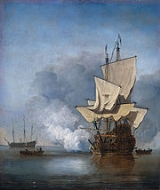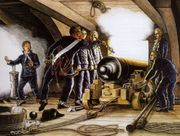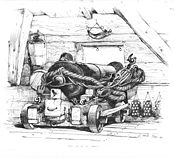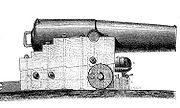
Naval artillery in the Age of Sail
Encyclopedia
.jpg)
Age of Sail
The Age of Sail was the period in which international trade and naval warfare were dominated by sailing ships, lasting from the 16th to the mid 19th century...
encompasses the period of roughly 1571-1863: when large, sail-powered wooden naval warships dominated the high seas, mounting a bewildering variety of different types and sizes of cannon
Cannon
A cannon is any piece of artillery that uses gunpowder or other usually explosive-based propellents to launch a projectile. Cannon vary in caliber, range, mobility, rate of fire, angle of fire, and firepower; different forms of cannon combine and balance these attributes in varying degrees,...
as their main armament. By modern standards, these cannon were extremely inefficient, difficult to load, and short ranged. These characteristics, along with the handling and seamanship of the ships that mounted them, defined the environment in which the Naval tactics in the Age of Sail
Naval tactics in the Age of Sail
Naval tactics in the Age of Sail were used from the early 17th century onward when sailing ships replaced oared galleys. These were used until the 1860s when steam-powered ironclad warships rendered sailing line of battle ships obsolete.-Early history:...
developed.
Firing


The firing procedure for a cannon was as follows: A wet swab was used to mop out the interior of the barrel, extinguishing any embers from a previous firing which might cause the next charge of gunpowder to go off prematurely. Gunpowder, either loose or in a cloth or parchment cartridge (in which case it would have a hole made in it with a metal 'pricker' through the touch hole), was placed in the barrel, followed by a cloth wad (typically made from canvas and old rope), and rammed home with a rammer. Next the shot was rammed in, followed by another wad (to prevent the cannon ball from rolling out of the barrel if the muzzle was depressed.) The gun in its carriage was then 'run out' — men heaved on the gun tackles until the front of the gun carriage was hard up against the ship's bulwark, and the barrel protruding out of the gun port. This took the majority of the manpower as the total weight of a large cannon in its carriage could reach over two tons, and the ship would probably be rolling. The touch hole in the rear ('breech') of the cannon was filled with finer gunpowder ('priming powder'), or a 'quill' (literally the quill from an animal such as a porcupine, or the skin-end of a feather, pre-filled with priming powder; using these obviated the need to separately pierce the cartridge by pricking) and ignited.
The earlier method of firing a cannon was to apply a linstock
Linstock
A linstock is a staff with a fork at one end to hold a lighted slow match. The name was adapted from the Dutch lontstok, "match stick"...
- a wooden staff holding a length of smoldering match at the end - to the touch-hole of the gun. This was dangerous and made accurate shooting from a moving ship difficult, as the gun had to be fired from the side, to avoid its recoil, and there was a noticeable delay between the application of the linstock and the gun firing. In 1745, the British began using gunlocks (flintlock mechanism
Flintlock mechanism
The flintlock mechanism was a firing mechanism used on muskets and rifles in the 17th, 18th, and 19th centuries. It is commonly referred to as a "flintlock" , though that term is also commonly used for the weapons themselves as a whole, and not just the lock mechanism.The flintlock was developed in...
s fitted to cannon).
The gunlock was operated by pulling a cord, or lanyard
Lanyard
A lanyard is a rope or cord exclusively worn around the neck or wrist to carry something. Usually it is used where there is a risk of losing the object or to ensure it is visible at all times. Aboard a ship, it may refer to a piece of rigging used to secure objects...
. The gun-captain could stand behind the gun, safely beyond its range of recoil, and sight along the barrel, firing when the roll of the ship lined the gun up with the enemy and so avoid the chance of the shot hitting the sea or flying high over the enemy's deck.. Despite their advantages, their use spread gradually as they could not be retrofitted to older guns. The British adopted them faster than the French, who had still not generally adopted them by the time of the Battle of Trafalgar (1805), placing them at a disadvantage as they were in general use by the Royal Navy at this time. After the introduction of gunlocks, linstocks were retained, but only as a backup means of firing.
The linstock slow match, or the spark from the flintlock, ignited the priming powder, which in turn set off the main charge, which propelled the shot out of the barrel. When the gun discharged, the recoil sent it backwards until it was stopped by the breech rope — a sturdy rope made fast to ring bolts let into the bulwarks, and a turn taken about the gun's cascabel, the knob at the end of the gun barrel.
A typical broadside of a Royal Navy ship of the late 18th century could be fired 2-3 times in approximately 5 minutes, depending on the training of the crew, a well trained one being essential to the simple yet detailed process of preparing to fire. Ironically, the British Admiralty did not see fit to provide additional powder to captains to train their crews, generally only allowing 1/3 of the powder loaded onto the ship to be fired in the first six months of a typical voyage, barring hostile action. Instead of live fire practice, most captains exercised their crews by "running" the guns in and out — performing all the steps associated with firing but for the actual discharge. Some wealthy captains — those who had made money capturing prizes or from wealthy families — were known to purchase powder with their own funds to enable their crews to fire real discharges at real targets.
Artillery types

Some types include:
- GunGunA gun is a muzzle or breech-loaded projectile-firing weapon. There are various definitions depending on the nation and branch of service. A "gun" may be distinguished from other firearms in being a crew-served weapon such as a howitzer or mortar, as opposed to a small arm like a rifle or pistol,...
- Demi-cannonDemi-cannonThe demi-cannon was a medium sized cannon, similar to but slightly larger than a culverin and smaller than a regular 42lb cannon developed in the early 17th century. A full cannon fired a 42-pound shot but these were discontinued in the 18th century as they were seen as too unwieldy. The lower...
- CulverinCulverinA culverin was a relatively simple ancestor of the musket, and later a medieval cannon, adapted for use by the French in the 15th century, and later adapted for naval use by the English in the late 16th century. The culverin was used to bombard targets from a distance. The weapon had a...
- Demi-culverinDemi-culverinThe demi-culverin was a medium cannon similar to but slightly larger than a saker and smaller than a regular culverin developed in the early 17th century. Barrels of demi-culverins were typically about long, had a calibre of and could weigh up to . It required of black powder to fire an round...
- CarronadeCarronadeThe carronade was a short smoothbore, cast iron cannon, developed for the Royal Navy by the Carron Company, an ironworks in Falkirk, Scotland, UK. It was used from the 1770s to the 1850s. Its main function was to serve as a powerful, short-range anti-ship and anti-crew weapon...
- Paixhans gunPaixhans gunThe Paixhans gun was the first naval gun designed to fire explosive shells. It was developed by the French general Henri-Joseph Paixhans in 1822-1823.-Background:...
One descriptive characteristic which was commonly used was to define guns by their pound rating: theoretically, the weight of a single solid iron shot fired by that bore of cannon. Common sizes were 42-pounders, 32-pounders, 24-pounders, 18-pounders, 12-pounders
Twelve-pound cannon
The twelve-pound cannon is a cannon that fires twelve-pound projectiles from its barrel, as well as grapeshot, chainshot, shrapnel, and later shells and canister shot. It was first used during the Tudor period and reached its production top in the Napoleonic wars...
, 9-pounders, 8-pounders, 6-pounders, and various smaller calibres. French ships used standardized guns of 36-pound, 24-pound and 12-pound
12-pounder gun
12-pounder gun or 12-pdr, usually denotes a gun which fired a projectile of approximately 12 pounds.Guns of this type include:* A cannon sized for a 12 pound ball, see Naval artillery in the Age of Sail*Canon de 12 de Vallière French canon of 1732...
calibres, augmented by carronades and smaller pieces. In general, larger ships carrying more guns carried larger ones as well.
The muzzle-loading design and weight of the iron placed design constraints on the length and size of naval guns. Muzzle loading required the cannon to be positioned within the hull of the ship for loading. The hull is only so wide, with guns on both sides, and hatchways in the centre of the deck also limit the room available. Weight is always a great concern in ship design as it affects speed, stability, and buoyancy. The desire for longer guns for greater range and accuracy, and greater weight of shot for more destructive power, led to some interesting gun designs.
Long Nine
One unique naval gun was the long nine. It was a proportionately longer-barrelled 9-pounder. Its typical mounting as a bow or stern chaser, where it was not perpendicular to the keel, allowed room to operate this longer weapon. In a chase situation, the gun's greater range came into play. However, the desire to reduce weight in the ends of the ship and the relative fragility of the bow and stern portions of the hull limited this role to a 9-pounder, rather than one which used a 12 or 24 pound shot.Carronade

Paixhans gun

Paixhans gun
The Paixhans gun was the first naval gun designed to fire explosive shells. It was developed by the French general Henri-Joseph Paixhans in 1822-1823.-Background:...
(French: Canon Paixhans) was the first naval gun using explosive shells. It was developed by the French general Henri-Joseph Paixhans
Henri-Joseph Paixhans
Henri-Joseph Paixhans was a French artillery officer of the beginning of the 19th century.Henri-Joseph Paixhans graduated from the École Polytechnique...
in 1822-1823, by combining the flat trajectory of a gun with an explosive shell that could rip apart and put on fire the bulkheads of enemy warships. The Paixhans gun ultimately doomed the wooden sailship, and forced the introduction of the ironclad after the Battle of Sinop
Battle of Sinop
The Battle of Sinop, or the Battle of Sinope, took place on 30 November 1853 at Sinop, a sea port in northern Anatolia, when Imperial Russian warships struck and annihilated a patrol force of Ottoman ships anchored in the harbor...
in 1853.
Shot
In addition to varying shot weights, different types of shot were employed for various situations:- Round shotRound shotRound shot is a solid projectile without explosive charge, fired from a cannon. As the name implies, round shot is spherical; its diameter is slightly less than the bore of the gun it is fired from.Round shot was made in early times from dressed stone, but by the 17th century, from iron...
- Solid spherical cast-iron shot, the standard fare in naval battles. - Canister shotCanister shotCanister shot is a kind of anti-personnel ammunition used in cannons. It was similar to the naval grapeshot, but fired smaller and more numerous balls, which did not have to punch through the wooden hull of a ship...
- Cans filled with dozens of musket balls. The cans broke open on firing to turn the gun into a giant shotgun for use against enemy personnel. - GrapeshotGrapeshotIn artillery, a grapeshot is a type of shot that is not a one solid element, but a mass of small metal balls or slugs packed tightly into a canvas bag. It was used both in land and naval warfare. When assembled, the balls resembled a cluster of grapes, hence the name...
- Canvas-wrapped stacks of smaller round shot which fitted in the barrel, typically three or more layers of three. Some grape shot was made with thin metal or wood disks between the layers, held together by a central bolt. The packages broke open when fired and the balls scattered with deadly effect. Grape was often used against the enemy quarterdeck to kill or injure the officers, or against enemy boarding parties. - Chain-shotChain-shotIn artillery, a chain-shot is an obsolete type of naval ammunition formed of two sub-calibre balls, or half-balls, chained together. Bar shot is similar, but joined by a solid bar...
- Two iron balls joined together with a chain. This type of shot was particularly effective against riggingRiggingRigging is the apparatus through which the force of the wind is used to propel sailboats and sailing ships forward. This includes masts, yards, sails, and cordage.-Terms and classifications:...
, boarding netting and sails since the balls and chain would whirl like bolasBolasBolas are a throwing weapon superficially similar to the surujin, made of weights on the ends of interconnected cords, designed to capture animals by entangling their legs...
when fired. - Bar shot - Two balls or hemispheres joined by a solid bar. Their effect was similar to chain shot.
- Expanding bar shot - Bar shot connected by a telescoping bar which extended upon firing.
- Link shot - A series of long chain links which unfolded and extended upon firing.
- Langrage - Bags of any old junk — scrap metal, bolts, rocks, gravel, old musket balls, etc. — fired to injure enemy crews.
- Fire arrowFire ArrowFire arrows are an early form of gun powder rocket which were attached to a stick. The Chinese are credited with the first use of fire arrows in a military application, they may have developed fire arrows from their use of fireworks.- Design :...
s - A thick dartlike incendiary projectile with a barbed point, wrapped with pitch-soaked canvas which took fire when the gun was fired. The point stuck in sails, hulls or spars and set fire to the enemy ship. - Heated shot - Shore forts sometimes heated iron shot red-hot in a special furnace before loading it (with water-soaked wads to prevent it from setting off the powder charge prematurely.) The hot shot lodging in a ship's dry timbers would set the ship afire. Because of the danger of fire aboard, heated shot were seldom used aboard ships.
- Double shot - Two round shot or other projectiles loaded in one gun and fired at the same time. Double-shotting lowered the effective range and accuracy of the gun, but could be devastating within pistol shot range — that is when ships drew close enough for a pistol shot to reach between the two ships. To avoid bursting the gun, reduced powder charges were used. Guns sometimes were double-shotted with canister or grape on top of ball, or even triple-shotted with very small powder charges which still were enough to cause horrible wounds at close range.
- Exploding shell - ammunition that worked like a grenade, exploding and sending shrapnel everywhere, either by a burning fuse which was cut to a calculated length depending on the range, or (after 1861) on contact with the target. Shells were often used in mortars, and specialized and reinforced "bomb vesselBomb vesselA bomb vessel, bomb ship, bomb ketch, or simply bomb was a type of wooden sailing naval ship. Its primary armament was not cannon —although bomb vessels carried a few cannon for self-defence—but rather mortars mounted forward near the bow and elevated to a high angle, and projecting their fire in a...
s" (often ketchKetchA ketch is a sailing craft with two masts: a main mast, and a shorter mizzen mast abaft of the main mast, but forward of the rudder post. Both masts are rigged mainly fore-and-aft. From one to three jibs may be carried forward of the main mast when going to windward...
-rigged so there was less rigging to obstruct the high-angle mortar shell) were adapted to fire huge mortars for shore bombardment. The "bombs bursting in air" over Fort McHenryFort McHenryFort McHenry, in Baltimore, Maryland, is a star-shaped fort best known for its role in the War of 1812, when it successfully defended Baltimore Harbor from an attack by the British navy in Chesapeake Bay...
in the American national anthemThe Star-Spangled Banner"The Star-Spangled Banner" is the national anthem of the United States of America. The lyrics come from "Defence of Fort McHenry", a poem written in 1814 by the 35-year-old lawyer and amateur poet, Francis Scott Key, after witnessing the bombardment of Fort McHenry by the British Royal Navy ships...
were this type of projectile.
See also
- Age of SailAge of SailThe Age of Sail was the period in which international trade and naval warfare were dominated by sailing ships, lasting from the 16th to the mid 19th century...
- CannonCannonA cannon is any piece of artillery that uses gunpowder or other usually explosive-based propellents to launch a projectile. Cannon vary in caliber, range, mobility, rate of fire, angle of fire, and firepower; different forms of cannon combine and balance these attributes in varying degrees,...
- Naval tactics in the Age of SailNaval tactics in the Age of SailNaval tactics in the Age of Sail were used from the early 17th century onward when sailing ships replaced oared galleys. These were used until the 1860s when steam-powered ironclad warships rendered sailing line of battle ships obsolete.-Early history:...
- CarronadeCarronadeThe carronade was a short smoothbore, cast iron cannon, developed for the Royal Navy by the Carron Company, an ironworks in Falkirk, Scotland, UK. It was used from the 1770s to the 1850s. Its main function was to serve as a powerful, short-range anti-ship and anti-crew weapon...
- Naval long gunNaval long gunIn historical naval usage, a long gun was the standard type of cannon mounted by a sailing vessel, so called to distinguish it from the much shorter carronades....
- HowitzerHowitzerA howitzer is a type of artillery piece characterized by a relatively short barrel and the use of comparatively small propellant charges to propel projectiles at relatively high trajectories, with a steep angle of descent...
- Naval artilleryNaval artilleryNaval artillery, or naval riflery, is artillery mounted on a warship for use in naval warfare. Naval artillery has historically been used to engage either other ships, or targets on land; in the latter role it is currently termed naval gunfire fire support...
Further reading
- Howard, Frank, "Early Ship Guns. Part I: Built-up Breech-loaders", Mariner's Mirror 72 (1986), pp. 439–53.
- Howard, Frank, "Early Ship Guns. Part II: Swivels", Mariner's Mirror 73 (1987), pp. 49–55.
- Rodger, Nicholas A. M., "The Development of Broadside Gunnery, 1450-1650." Mariner's Mirror 82, No. 3 (1996), pp. 301–24.
- Rodger, Nicholas, "Image and Reality in Eigteenth-Century Naval Tactics." Mariner's Mirror 89, No. 3 (2003), pp. 281–96.

